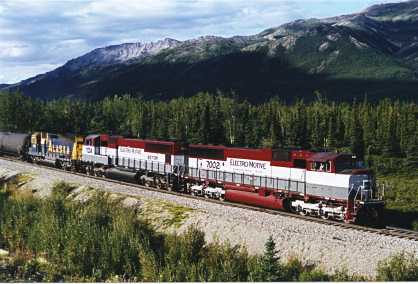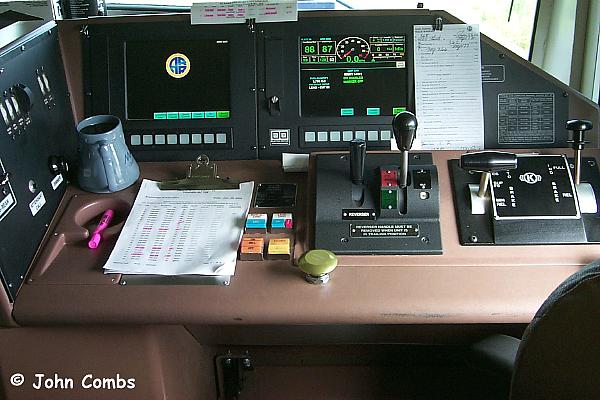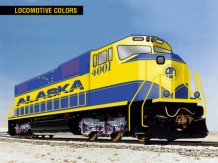
Overview
When the initial SD70MAC rolled off the manufacturing floor in November 1993, it represented the first in AC traction technology for North American freight hauling. Now these 4,000hp 415,000lb units will forever change the face of the Alaska Railroad for years to come. As Gov. Bill Sheffield, president and CEO of the ARRC said in his September 20, 1997 memo to his employees, "The power of these units is amazing." Three "MACs" will replace the six GP40s it takes to haul the coal train south to Seward. For the railroad's bottom line it will provide increased performance, reliability and efficiency while decreasing fuel and maintenance costs. GM Electro-Motive Division has produced over 736 of these big boys so far (as of 9/12/99) and when the first summer of the new millennium arrives, the Alaska Railroad itself will have added 16 more.

History
Between May and August of 1997 the Alaska Railroad tested two SD70Ms, the direct current (DC) version of the SD70MAC. Numbers 7002 and 7004 operated gravel, coal and petroleum trains as well as passenger trains between Anchorage and Fairbanks and Anchorage and Seward. Engineers were delighted with the self steering trucks as well as the elimination of helper locomotives, but were concerned that the electronics and WhisperCab features might not hold up under frigid arctic conditions. There was also some concern whether the 115 pound rail would hold up to these 200 ton jackhammers over the years.
In a bold move, the Alaska Railroad Corporation placed an order for production of 16 SD70MACs at $1.9 million each (which included a three year warranty). These AC powered locomotives are Distributed Power Units (DPUs) and use ICE technology. The first four were delivered in December 1999 and the last one arrived in May 2000. The railroad uses the SD70MACs on unit gravel, coal and petroleum trains as well as dedicating one for its passenger trains. The railroad kept with its numbering scheme and these whopping 4,000 horsepower units were numbered 4001-4016. The paint scheme used the same blue and yellow, but was modified to coincide with its passenger trains. You may want to check out my favorite SD70MAC delivery photos.
In the spring of 2004 the Alaska Railroad purchased eight more SD70MACs. This was followed by an order for four more in the fall of 2007.
See the Alaska Railroad SD70MAC Fast Sheet
SD70MAC Console

Now sit down here at the SD70MACs console and let Al Krug, locomotive
engineer with BNSF brief you on the controls. "The big red button
near lower right of desk is the Alerter Reset. The big gold button is the
ditch light flasher. The far right lever is the Independent Brakes
(loco brakes). Next lever left is the Automatic Brake (train brakes). Next
is the Throttle/Dynamic Brake controller. Last is the Reverser (hard to
see in photo). The four square switches left of the levers are Horn,
Bell, Lead Axle Sand and All Axles Sand. Just to the right of the
radio handset are the headlight switches; you are looking at them from
the side. The two computer screens are obvious. Each has a row of
push buttons along its bottom edge. These are the function keys.
Overhead is the radio with its touch-tone keypad and volume and transmit
buttons. To the left of the radio are the heater/air conditioning
switches and the electrically heated windshield (defroster) switch. Far
right top is the emergency fuel cut off switch. The switch in the red square
to the right of the computers is the rear end emergency switch. It puts
FRED and thus the train into emergency from the rear end."

Close up view of the fireman's console
Three integrated display computers (one assembly for the conductor)
replace more than a dozen standard cab gauges, indicators and controls.
The assemblies are networked to each other to provide greater processing
power. Now, instead of one central computer, the FIRE system incorporates
as many as three.
ICE
The cabs will feature Rockwell's Collins Railroad Electronics (RRE) Integrated Cab Electronics (ICE) screen based instrumentation for maximum operating efficiency. ICE is designed and built by Rockwell and is based on Rockwell's aerospace technology, ensuring extremely high levels of reliability are achieved. As part of the ICE, now standard equipment on almost all new EMD locomotives, most gauges, control switches, and indicators in the cab have been replaced by two computer-driven display screens built into the control console. Featuring multiple display options, a single-screen display provides the engineer with a wealth of data, including the unit number and locomotive weight, air brake pressures and configuration, train length, locomotive speed, tractive and dynamic braking effort, acceleration and throttle positions, and operating conditions and warnings, along with fuel quantity, last car ID, train status, and end-of-train device functions.
Although ICE was developed by Rockwell's Collins Railroad Electronics (RRE) business unit, it was later bought out by Westinghouse Air Brake Company ).
Paint Scheme
For months Alaska Railroad fans from around the world speculated on the new SD70MAC's paint scheme. When the ARRC finally released an artist's concept of this scheme on their web site, I found people's opinions to be mixed. To give us a better view of the font type used for the bold "Alaska" on the side of each locomotive, Willow Peyton, ARRC webmaster, sent us a sample. Steve Wiedmer from Sins, Switzerland put the two together and came up with the image below.
I asked the ARRC to make arrangements for me to visit GM EMD's plant and photograph the manufacture of these beautiful work horses. ARRC President and CEO Bill Sheffield made a request on my behalf, but was turned down by GM's public affairs office.
Artist's Concept
(by Northwest Strategies)

Click on image for a bigger view
Adaptation of New Paint Scheme

Paint design by Steve Wiedmer
SD70M drawing copyright 1999 by Joshua Moldover and provided by the
Railroad
Paint Shop.
All rights reserved. Used by permission.
The paint scheme was an EMD paint template, and other than the color choice, it is identical to the BN "executive" scheme.
Specifications and Features
(for all you mechanical geeks)
| Specifications
* 4000 THP
|
Features
* 4000 THP
|
Power with diesel-electric propulsion technology: Siemens introduced AC traction technology to the North American locomotive market. The SD70MAC freight locomotive combines quick acceleration with high continuous power for hauling the heaviest loads.
The SD70MAC is a 4000hp AC freight locomotive. This diesel uses a 16-cylinder prime-mover for higher tractive and braking effort capability. There is also an 11% improvement in fuel efficiency over the SD40-2.
The SD70MAC has true 92-day maintenance intervals and the AC traction motors double traction motor life. The SD70MAC has a high level of reliability, a 1 million mile overhaul period with radial trucks, 6 year engine overhaul period, and EM2000 advanced microprocessor controls. This locomotives also offers increased speed and efficiency and reduced parts.
As usual, the SD70MAC satisfies all FRA/AAR crash worthiness requirements features optional impact resistant fuel tank minimizing spills and leaks. Whisper Cab is responsible for the lowest cab sound and vibration levels in the industry. The SD70MAC also has frame mounted anti-climbers improving crew and equipment protection.
Check out GM EMD for detailed SD70MAC information
Terminology
Adhesion - The percentage of a locomotive's weight on driving wheels that is converted into tractive effort (note: D.C. locomotives may have reached their peak at 30% while A.C. locomotives have produced up to 45 percent adhesion under test conditions. The upper limits of A.C. traction are still unknown, but design engineers speak enthusiastically of achieving 50 percent adhesion factors in the foreseeable future.
Dynamic Braking - A method of train braking where the kinetic energy from the train movement generates current at the locomotive traction motors, and is dissipated in a resistor grid on the locomotive.
FRED - Flashing Rear End Device: A blinking red light on the last car of the train used as an end of train telemetry device
ICE - Integrate Cab Electronics: Screen based instrumentation which provides the engineer with operational data such as air brake pressures, locomotive speed, fuel quantity, etc.
MAC - It's going to take a little bit to explain this one.
Consider the following:
- SD70M: wide nose and "safety" cab;
provides greater collision protection and a more comfortable crew work
area
- SD70I: an SD70M with
"WhisperCab"
(cab is partially Isolated from the rest of the locomotive to reduce
noise & vibration)
- SD70MAC: an SD70M with an
alternating-current (A.C.) drive system.
Now one might think that an SD70MAC with the additional "WhisperCab"
feature would be called an SD70IMAC, but an IMAC is an Apple Macintosh
computer. Therefore, a MAC can either be a "safety" cab or "WhisperCab".
Self Steering Trucks - Trucks which allow the axles to steer through the curves to ensure minimal wheel flange and track wear. It also increases adhesion performance by minimizing weight-shift and better balancing traction motor loads.
Wilma - FRED's wife
Page created10/18/99 and last updated 7/31/24